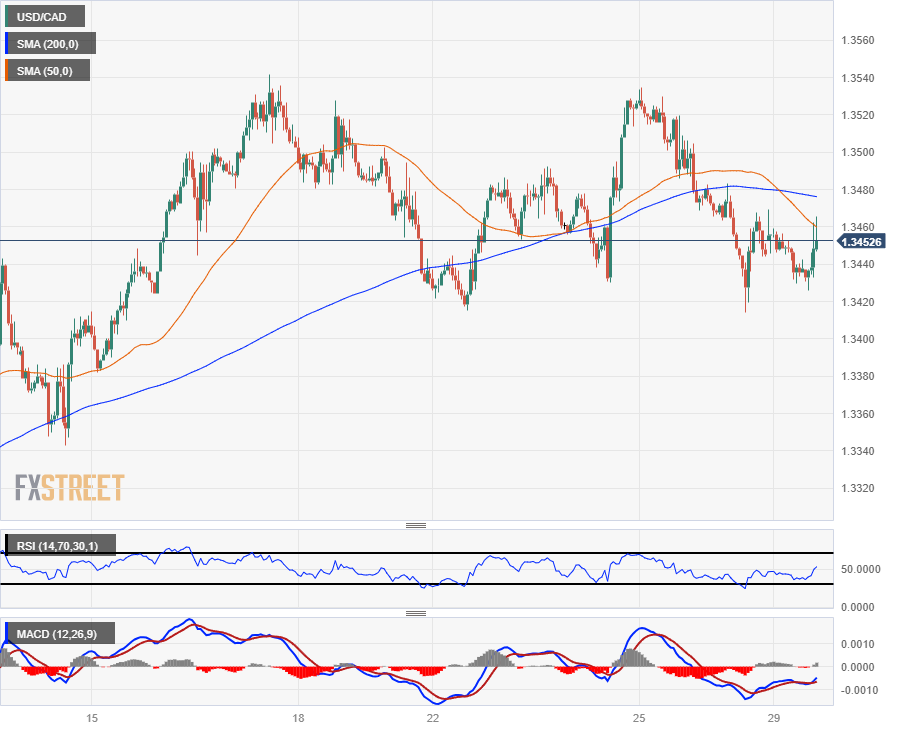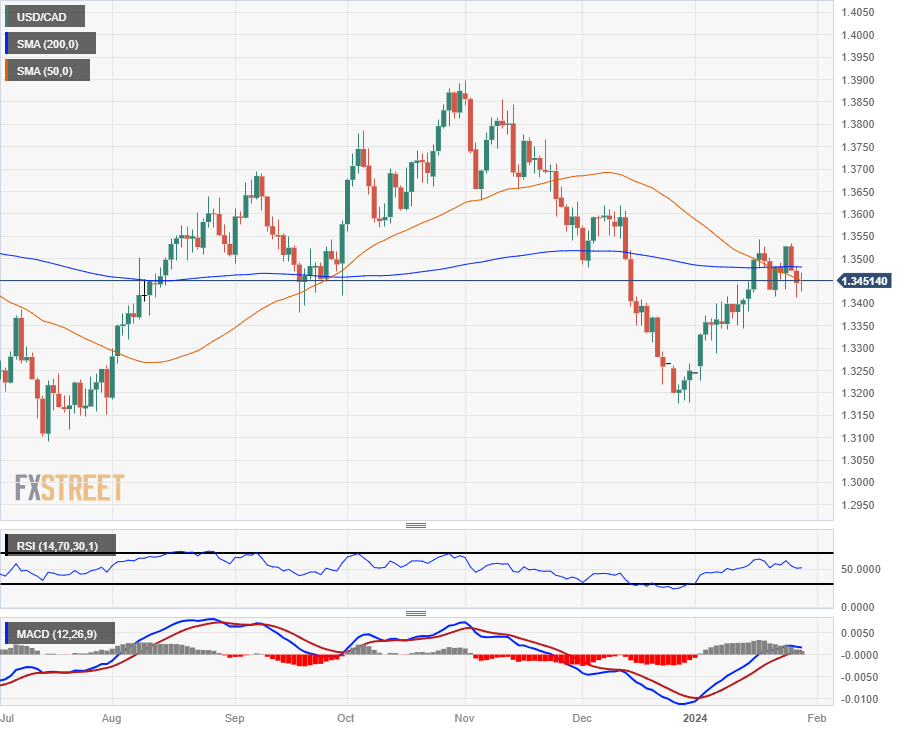- Analytics
- News and Tools
- Market News
- Canadian Dollar softens on Crude Oil hesitation with Canada GDP, US Fed rate call in the pipe
Canadian Dollar softens on Crude Oil hesitation with Canada GDP, US Fed rate call in the pipe
- Canadian Dollar trimmed recent gains as energy markets continue to roil.
- Canada absent from economic data docket until Wednesday’s Canadian GDP print.
- Crude Oil pared back recent highs on Red Sea headlines, China growth concerns.
The Canadian Dollar (CAD) eased on Monday, backsliding after Crude Oil markets snipped away the week’s opening highs as the trading week kicks off with a light economic calendar on offer. The midweek period will see an update on Canadian Gross Domestic Product (GDP) and another rate call from the US Federal Reserve (Fed), both slated for Wednesday, and Friday will wrap up the week’s trading action with US Nonfarm Payrolls (NFP).
Canada is expected to see a slight uptick in GDP figures on Wednesday, with November’s MoM GDP forecast to print at 0.1% compared to the flat 0.0% from October, but broad-market focus will be on the Fed’s upcoming rate call and monetary policy statement at 19:00 GMT Wednesday. The Fed will follow up their latest interest rate decision with a press conference at 19:30 GMT.
Daily digest market movers: Canadian Dollar eases on early Crude Oil reversal
- Canadian Dollar down against most of major currencies on Monday.
- Crude Oil markets saw an early high to kick off the trading week, but barrel bids quickly fell back into near-term consolidation, dragging the Loonie lower.
- Iran-backed Houthi rebels in Yemen struck a commercial tanker in the Red Sea over the weekend, and energy markets spiked as retaliation is expected.
- China saw one of its lowest growth periods on record, excluding the Covid pandemic crunch.
- Concerns that the world’s largest Crude Oil importer sees slowing barrel demand is trimming energy bids, capping oil upside.
- Money markets are keen for a rate pivot from the Fed on Wednesday.
- Rate swaps this week are pricing in an 89.5% chance of a Fed rate cut of at least 25 basis points at the Fed’s May meeting, according to CME FedWatch Tool.
- Canada has a thin showing on the economic calendar this week, with Wednesday’s November GDP print and Thursday’s S&P Global Manufacturing Purchasing Managers’ Index (PMI) the only notable lines on the Canadian side.
Canadian Dollar price today
The table below shows the percentage change of Canadian Dollar (CAD) against listed major currencies today. Canadian Dollar was the weakest against the Japanese Yen.
| USD | EUR | GBP | CAD | AUD | JPY | NZD | CHF | |
| USD | 0.35% | 0.08% | 0.00% | -0.23% | -0.36% | -0.31% | -0.11% | |
| EUR | -0.35% | -0.25% | -0.33% | -0.57% | -0.68% | -0.65% | -0.45% | |
| GBP | -0.11% | 0.25% | -0.10% | -0.32% | -0.42% | -0.40% | -0.20% | |
| CAD | 0.00% | 0.34% | 0.08% | -0.22% | -0.33% | -0.29% | -0.10% | |
| AUD | 0.22% | 0.56% | 0.30% | 0.22% | -0.12% | -0.08% | 0.11% | |
| JPY | 0.35% | 0.66% | 0.56% | 0.32% | 0.09% | 0.01% | 0.24% | |
| NZD | 0.31% | 0.66% | 0.40% | 0.29% | 0.08% | -0.05% | 0.20% | |
| CHF | 0.11% | 0.43% | 0.19% | 0.10% | -0.12% | -0.24% | -0.19% |
The heat map shows percentage changes of major currencies against each other. The base currency is picked from the left column, while the quote currency is picked from the top row. For example, if you pick the Euro from the left column and move along the horizontal line to the Japanese Yen, the percentage change displayed in the box will represent EUR (base)/JPY (quote).
Technical Analysis: Canadian Dollar pares back on Monday, chews into recent upswing
The Canadian Dollar (CAD) is broadly lower on Monday, declining against most of its major currency pairs.
The Canadian Dollar is down a fifth to a quarter of a percent against the Antipodeans as well as the Japanese Yen (JPY), while it sticks close to flat against the US Dollar (USD). The CAD has gained four-tenths of a percent against the Euro (EUR) and one-sixth of a percent against the Pound Sterling (GBP) as the European bloc sees Monday’s weakest performance.
The USD/CAD pair remains stuck in congestion near 1.3450 as bids get hung up on near-term medians with price action hampered by the 200-hour Simple Moving Average (SMA) near 1.3480.
Daily candlesticks remain stuck closely to the 200-day SMA near 1.3500, and a lack of chart momentum sees a congestion pattern settling into the USD/CAD.
With the 50-SMA drifting into the low side of the long-term 200-day SMA, potential is on the rise for a bearish break toward December’s swing low into the 1.3200 handle.
USD/CAD Hourly Chart
USD/CAD Daily Chart
Canadian Dollar FAQs
What key factors drive the Canadian Dollar?
The key factors driving the Canadian Dollar (CAD) are the level of interest rates set by the Bank of Canada (BoC), the price of Oil, Canada’s largest export, the health of its economy, inflation and the Trade Balance, which is the difference between the value of Canada’s exports versus its imports. Other factors include market sentiment – whether investors are taking on more risky assets (risk-on) or seeking safe-havens (risk-off) – with risk-on being CAD-positive. As its largest trading partner, the health of the US economy is also a key factor influencing the Canadian Dollar.
How do the decisions of the Bank of Canada impact the Canadian Dollar?
The Bank of Canada (BoC) has a significant influence on the Canadian Dollar by setting the level of interest rates that banks can lend to one another. This influences the level of interest rates for everyone. The main goal of the BoC is to maintain inflation at 1-3% by adjusting interest rates up or down. Relatively higher interest rates tend to be positive for the CAD. The Bank of Canada can also use quantitative easing and tightening to influence credit conditions, with the former CAD-negative and the latter CAD-positive.
How does the price of Oil impact the Canadian Dollar?
The price of Oil is a key factor impacting the value of the Canadian Dollar. Petroleum is Canada’s biggest export, so Oil price tends to have an immediate impact on the CAD value. Generally, if Oil price rises CAD also goes up, as aggregate demand for the currency increases. The opposite is the case if the price of Oil falls. Higher Oil prices also tend to result in a greater likelihood of a positive Trade Balance, which is also supportive of the CAD.
How does inflation data impact the value of the Canadian Dollar?
While inflation had always traditionally been thought of as a negative factor for a currency since it lowers the value of money, the opposite has actually been the case in modern times with the relaxation of cross-border capital controls. Higher inflation tends to lead central banks to put up interest rates which attracts more capital inflows from global investors seeking a lucrative place to keep their money. This increases demand for the local currency, which in Canada’s case is the Canadian Dollar.
How does economic data influence the value of the Canadian Dollar?
Macroeconomic data releases gauge the health of the economy and can have an impact on the Canadian Dollar. Indicators such as GDP, Manufacturing and Services PMIs, employment, and consumer sentiment surveys can all influence the direction of the CAD. A strong economy is good for the Canadian Dollar. Not only does it attract more foreign investment but it may encourage the Bank of Canada to put up interest rates, leading to a stronger currency. If economic data is weak, however, the CAD is likely to fall.
© 2000-2024. All rights reserved.
This site is managed by Teletrade D.J. LLC 2351 LLC 2022 (Euro House, Richmond Hill Road, Kingstown, VC0100, St. Vincent and the Grenadines).
The information on this website is for informational purposes only and does not constitute any investment advice.
The company does not serve or provide services to customers who are residents of the US, Canada, Iran, The Democratic People's Republic of Korea, Yemen and FATF blacklisted countries.
Making transactions on financial markets with marginal financial instruments opens up wide possibilities and allows investors who are willing to take risks to earn high profits, carrying a potentially high risk of losses at the same time. Therefore you should responsibly approach the issue of choosing the appropriate investment strategy, taking the available resources into account, before starting trading.
Use of the information: full or partial use of materials from this website must always be referenced to TeleTrade as the source of information. Use of the materials on the Internet must be accompanied by a hyperlink to teletrade.org. Automatic import of materials and information from this website is prohibited.
Please contact our PR department if you have any questions or need assistance at pr@teletrade.global.















